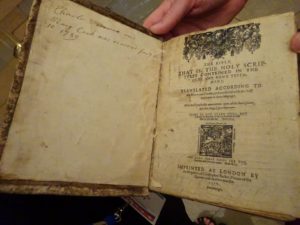
The Vulgate to KJV
Last week, we journeyed through Bible History from the giving of the Law (1450BC) to the Latin Vulgate (405AD). That left us with a complete Bible canon written in Latin. This week, we will continue moving forward in time and see the progression of the Bible from Latin to English.
1382 Wycliffe Bible
John Wycliffe was a Catholic Theologian who strongly believed people should hear and read the Bible in their common language. At this time, most English-speaking people only heard Latin Scripture read during church. Wycliffe was criticized by both the Catholic Church and English rulers but moved forward with his mission to translate the Vulgate into English. After his death, Wycliffe was declared a heretic and the majority of his writings and translations burned.
1526 Tyndale Bible
William Tyndale was the first to compile a complete English translation from Greek and Hebrew. Challenging the control of Scripture by both the Catholic Church and English government, Tyndale believed everyone should be able to hear and read the Word in the language they understood. These beliefs endangered his life and he was forced to flee to Belgium. In 1526, the first New Testament copies were smuggled into England and made him many more enemies. He was burned at the stake in 1537 praying, “Lord, open the king of England’s eyes.”
1539 Great Bible
Miles Coverdale led an expanded translation of Tyndale’s work. This large, ornate edition (11”x16.5”) was the first authorized version of the English Bible and King Henry VIII ordered its use in all Church of England services. Tyndale’s prayer was answered.
1560 Geneva Bible
As the English throne teetered back and forth between Catholic and Protestant monarchs, mainland Europe became a popular refuge for those persecuted. In addition to Coverdale’s initial translation coming from exile, so did the Geneva Bible. Affordable as well as smaller-sized, the Geneva Bible was also the first version with numbered verses. Favored by the Puritans, this was the translation carried to America.
1611 King James Bible (KJV)
In response to ongoing problems with the Puritans, King James I authorized another English translation. Unique in style and “upgraded” features, it quickly became the most popular of English Bibles. Many Christians today still prefer the KJV translation or at least are most familiar with it for certain verses.
Since 1611, there have been many translations of the English Bible. In modern times, there are specialized Bibles, Study Bibles, Children’s Bibles, and Journaling Bibles. There are online versions, audio versions, and dramatized versions. The age-old question may always be: “Which version is the right version?” Perhaps the best reply will always be: “Whichever one you will read.”

Wonderful part of the Bible people are unaware of, and don’t even think to research.
Thank you for helping open people’s eyes.